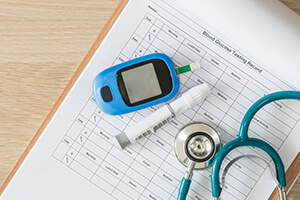November is national diabetes Month
November is National Diabetes Month, a time focused on educating our community about the risk factors for diabetes, encouraging a healthier lifestyle to prevent diabetes and helping people with diabetes live life to the fullest.
Diabetes is a chronic disease caused by a body’s problems with insulin, a hormone that helps the cells use sugar (glucose).
There are three types of diabetes.
- Type 1 diabetes is an autoimmune disease. It typically occurs early in life and requires daily insulin via injection or insulin pump because the body does not produce enough insulin. There is not a cure. Checking blood sugar throughout the day, eating a healthy diet and regular exercise can keep the individual healthy and help them avoid complications.
- Type 2 diabetes typically occurs later in life. The body makes insulin but can’t use it properly. There is insulin resistance in the body’s cells. Risk factors include: obesity, fat distribution, family history, inactive lifestyle, ethnicity (African-American, Latino, Asian and Native American), prediabetes, gestational diabetes, and polycystic ovarian syndrome. Treatment includes healthy diet, exercise, and if necessary, oral medication and/or insulin injections.
- Gestational diabetes accounts for 90 percent of diabetes in pregnancy. It is usually diagnosed at 24-28 weeks. Pregnancy hormones can lead to insulin resistance and high blood sugar levels. Uncontrolled high blood sugar can cause the baby to grow larger than normal, leading to a difficult delivery. Treatment may include changes in diet and exercise, blood sugar testing and if necessary, insulin injections to help control blood sugar levels.
Controlling blood sugar is vital. Chronically high blood sugar can lead to stroke, heart, kidney and nerve damage.
Healthy lifestyle changes are important in managing all types of diabetes, but can significantly lower your risk of developing type 2 diabetes.
- Be physically active. Exercising helps you manage or lose weight and lower blood sugar. Move as much as you can throughout the day: walk, dance, bike, swim or do yardwork. Learn more about increasing physical activity at Rx: Exercise, Fresh ideas to boost your step count and Hate the gym?
- Eat a healthy diet. Foods high in whole grains and fiber (nuts; fruits; vegetables; beans; “whole” grain breads, pastas and cereal; brown rice; and quinoa) can help blood sugar control and give you a feeling of fullness (which can help promote weight loss). Find more healthy eating tips at Healthy eating for busy families, Are your eyes bigger than your stomach and 4 easy food swaps.
- Lose extra weight. Every pound lost helps prevent diabetes. A good goal is to lose five to seven percent of your body weight. Eat smaller portions, choose healthy foods, drink water rather than sweetened beverages and increase your amount of physical activity.
